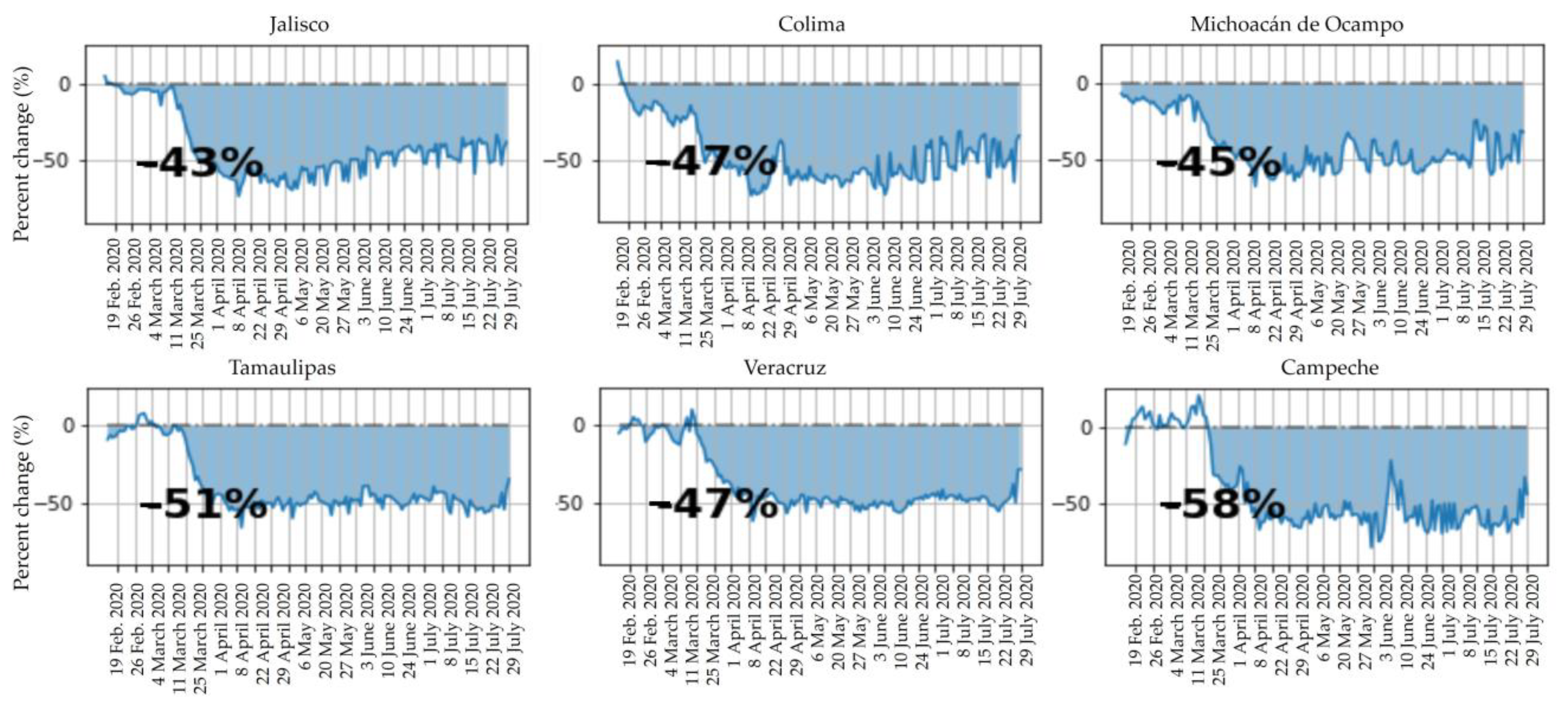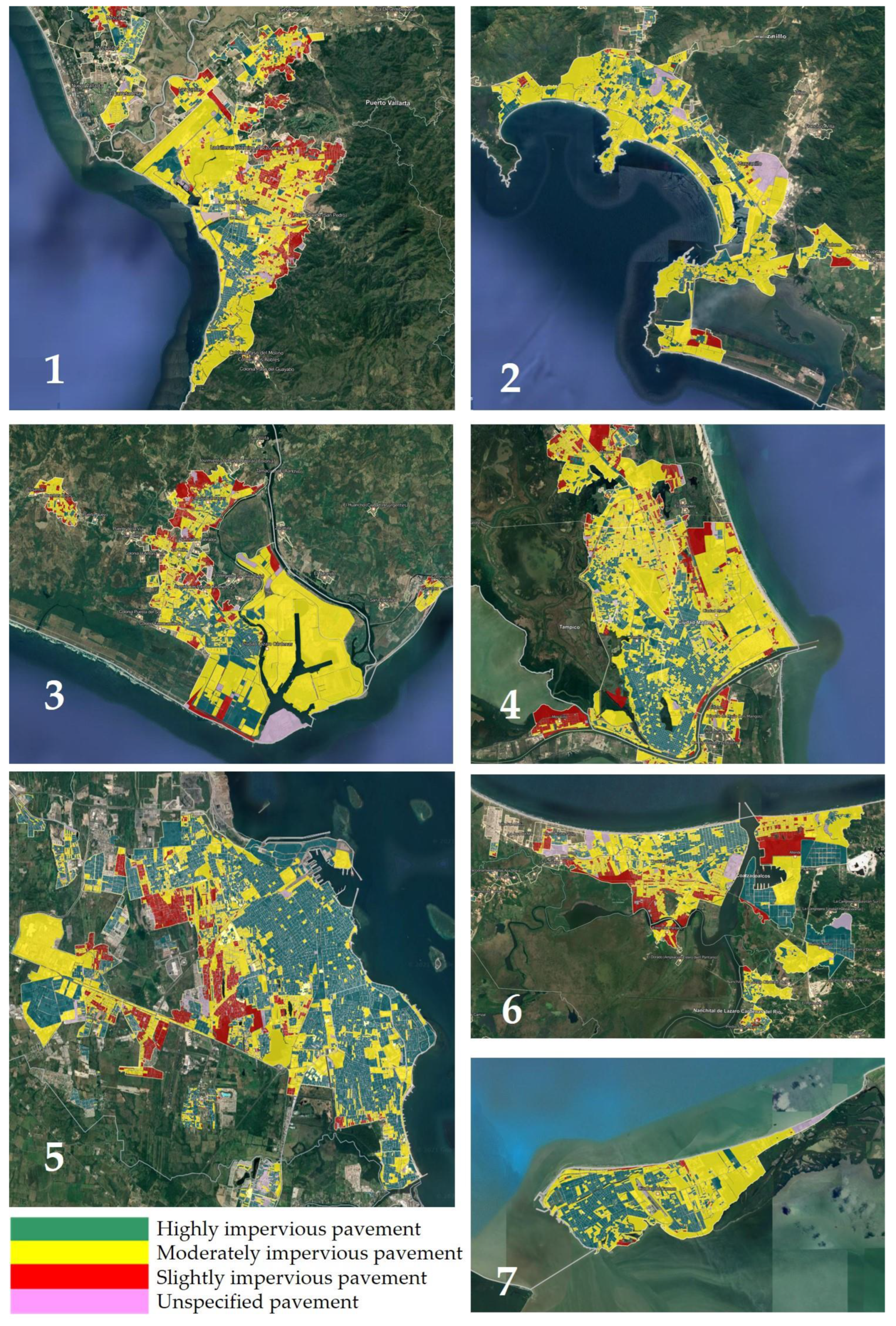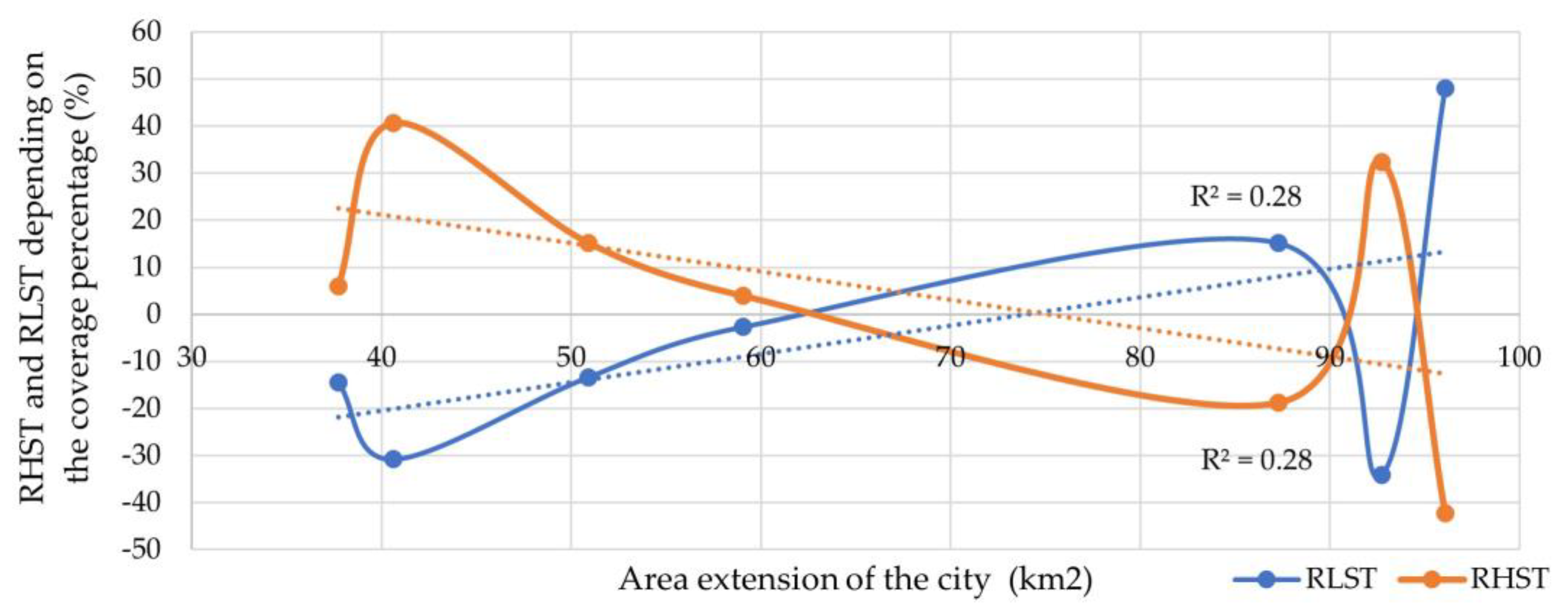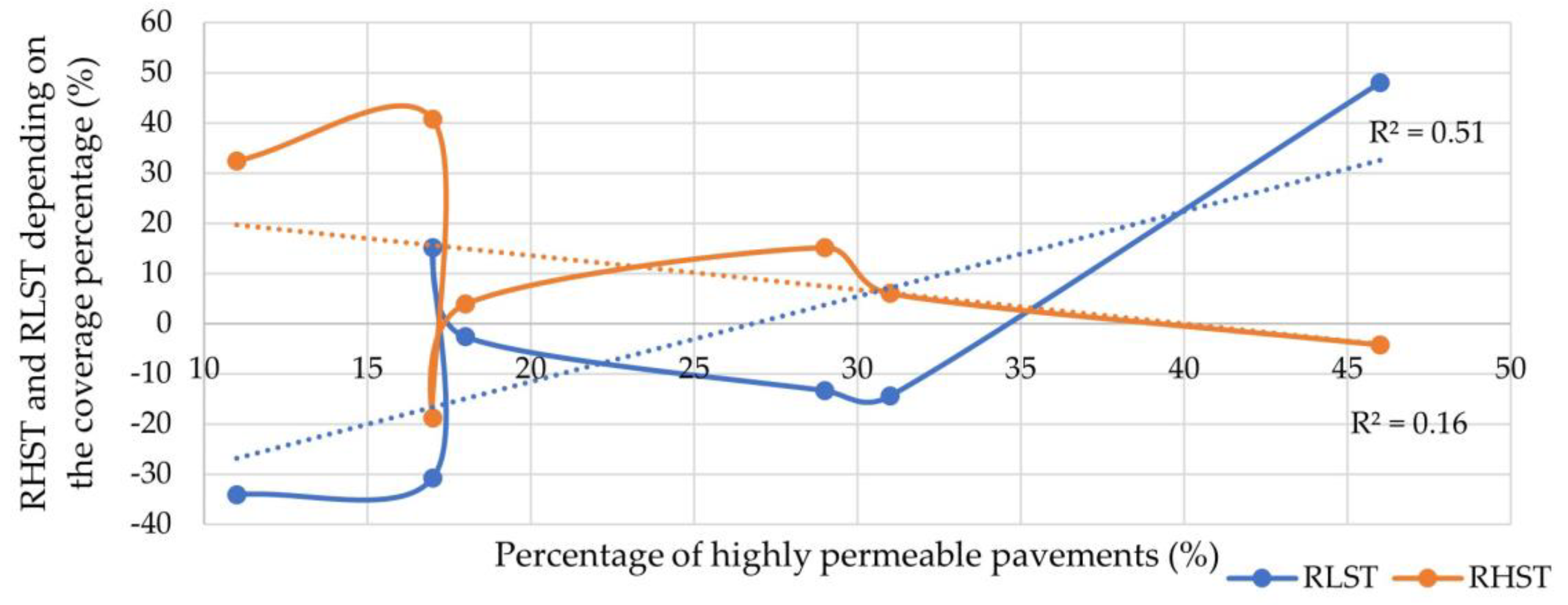Analysis of Surface Temperature Modified by Atypical Mobility in Mexican Coastal Cities with Warm Climates
Abstract
:1. Introduction
2. Study Area
3. Methodology
- σ = The Stefan–Boltzmann constant 5.67 × 10−8 W/(m2 K4);
- ε = The emissivity of the surface;
- T = The absolute temperature of the object (°K);
- Tc = The absolute temperature of the environment (°K).
3.1. Image Processing
3.2. Data Processing
4. Results
5. Conclusions
Author Contributions
Funding
Institutional Review Board Statement
Informed Consent Statement
Data Availability Statement
Acknowledgments
Conflicts of Interest
References
- Li, H.; Zhou, Y.; Li, X.; Meng, L.; Wang, X.; Wu, S.; Sodoudi, S. A new method to quantify surface urban heat island intensity. Sci. Total Environ. 2018, 624, 262–272. [Google Scholar] [CrossRef]
- Parsaee, M.; Joybari, M.M.; Mirzaei, P.A.; Haghighat, F. Urban heat island, urban climate maps and urban development policies and action plans. Environ. Technol. Innov. 2019, 14, 100341. [Google Scholar] [CrossRef]
- Peng, S.; Piao, S.; Ciais, P.; Friedlingstein, P.; Ottle, C.; Bréon, F.-M.; Nan, H.; Zhou, L.; Myneni, R.B. Surface urban heat island across 419 global big cities. Environ. Sci. Technol. 2012, 46, 696–703. [Google Scholar] [CrossRef]
- Kuttler, W.; Weber, S. Characteristics and phenomena of the urban climate. Meteorol. Z. 2023, 32, 15–47. [Google Scholar] [CrossRef]
- Hu, Y.; Hou, M.; Jia, G.; Zhao, C.; Zhen, X.; Xu, Y. Comparison of surface and canopy urban heat islands within megacities of eastern China. ISPRS J. Photogramm. Remote Sens. 2019, 156, 160–168. [Google Scholar] [CrossRef]
- Hung, T.; Uchihama, D.; Ochi, S.; Yasuoka, Y. Assessment with satellite data of the urban heat island effects in Asian mega cities. Int. J. Appl. Earth Obs. Geoinf. 2006, 8, 34–48. [Google Scholar]
- JSobrino, J.A.; Irakulis, I. A Methodology for Comparing the Surface Urban Heat Island in Selected Urban Agglomerations Around the World from Sentinel-3 SLSTR Data. Remote Sens. 2020, 12, 2052. [Google Scholar] [CrossRef]
- Lu, L.; Weng, Q.; Xiao, D.; Guo, H.; Li, Q.; Hui, W. Spatiotemporal variation of surface urban heat islands in relation to land cover composition and configuration: A multi-scale case study of Xi’an, China. Remote Sens. 2020, 12, 2713. [Google Scholar] [CrossRef]
- Stewart, I.D.; Krayenhoff, E.S.; Voogt, J.A.; Lachapelle, J.A.; Allen, M.A.; Broadbent, A.M. Time Evolution of the Surface Urban Heat Island. Earth’s Futur. 2021, 9, e2021EF002178. [Google Scholar] [CrossRef]
- Louiza, H.; Zéroual, A.; Djamel, H. Impact of the transport on the urban heat island. Int. J. Traffic Transp. Eng. 2015, 5, 252–263. [Google Scholar] [CrossRef] [PubMed]
- Kolbe, K. Mitigating urban heat island effect and carbon dioxide emissions through different mobility concepts: Comparison of conventional vehicles with electric vehicles, hydrogen vehicles and public transportation. Transp. Policy 2019, 80, 1–11. [Google Scholar] [CrossRef]
- Kim, Y.; Yeo, H.; Kim, Y. Estimating urban spatial temperatures considering anthropogenic heat release factors focusing on the mobility characteristics. Sustain. Cities Soc. 2022, 85, 104073. [Google Scholar] [CrossRef]
- Kusak, L.; Kucukali, U.F. Investigating the relationship between COVID-19 shutdown and land surface temperature on the Anatolian side of Istanbul using large architectural impermeable surfaces. Environ. Dev. Sustain. 2021, 26, 18439–18476. [Google Scholar] [CrossRef] [PubMed]
- Parida, B.R.; Bar, S.; Roberts, G.; Mandal, S.P.; Pandey, A.C.; Kumar, M.; Dash, J. Improvement in air quality and its impact on land surface temperature in major urban areas across India during the first lockdown of the pandemic. Environ. Res. 2021, 199, 111280. [Google Scholar] [CrossRef] [PubMed]
- Prusa, J.M.; Segal, M.; Temeyer, B.R.; Gallus, W.A.; Takle, E.S. Conceptual and scaling evaluation of vehicle traffic thermal effects on snow/ice-covered road. J. Appl. Meteorol. Climatol. 2002, 41, 1225–1240. [Google Scholar] [CrossRef]
- Chapman, L.; Thornes, J.E. The influence of traffic on road surface temperatures: Implications for thermal mapping studies. Meteorol. Appl. 2005, 12, 371–380. [Google Scholar] [CrossRef]
- Khalifa, A.; Marchetti, M.; Bouilloud, L.; Martin, E.; Bues, M.; Chancibaut, K. Accounting for anthropic energy flux of traffic in winter urban road surface temperature simulations with the TEB model. Geosci. Model Dev. 2016, 9, 547–565. [Google Scholar] [CrossRef]
- Zhou, B.; Rybski, D.; Kropp, J.P. The role of city size and urban form in the surface urban heat island. Sci. Rep. 2017, 7, 4791. [Google Scholar] [CrossRef]
- Zhou, B.; Rybski, D.; Kropp, J.P. On the statistics of urban heat island intensity. Geophys. Res. Lett. 2013, 40, 5486–5491. [Google Scholar] [CrossRef]
- Arnfield, A. Two decades of urban climate research: A review of turbulence, exchanges of energy and water, and the urban heat island. Int. J. Climatol. A J. R. Meteorol. Soc. 2003, 23, 1–26. [Google Scholar] [CrossRef]
- Zhao, L.; Lee, X.; Smith, R.B.; Oleson, K. Strong contributions of local background climate to urban heat islands. Nature 2014, 511, 216–219. [Google Scholar] [CrossRef] [PubMed]
- Dewan, A.; Kiselev, G.; Botje, D.; Mahmud, G.I.; Bhuian, M.H.; Hassan, Q.K. Surface urban heat island intensity in five major cities of Bangladesh: Patterns, drivers and trends. Sustain. Cities Soc. 2021, 71, 102926. [Google Scholar] [CrossRef]
- Ferrari, A.; Kubilay, A.; Derome, D.; Carmeliet, J. The use of permeable and reflective pavements as a potential strategy for urban heat island mitigation. Urban Clim. 2020, 31, 100534. [Google Scholar] [CrossRef]
- Morabito, M.; Crisci, A.; Guerri, G.; Messeri, A.; Congedo, L.; Munafò, M. Surface urban heat islands in Italian metropolitan cities: Tree cover and impervious surface influences. Sci. Total Environ. 2021, 751, 142334. [Google Scholar] [CrossRef] [PubMed]
- Chun, B.; Guldmann, J.-M. Impact of greening on the urban heat island: Seasonal variations and mitigation strategies. Comput. Environ. Urban Syst. 2018, 71, 165–176. [Google Scholar] [CrossRef]
- Fathizad, H.; Tazeh, M.; Kalantari, S.; Shojaei, S. The investigation of spatiotemporal variations of land surface temperature based on land use changes using NDVI in southwest of Iran. J. Afr. Earth Sci. 2017, 134, 249–256. [Google Scholar] [CrossRef]
- Neinavaz, E.; Skidmore, A.K.; Darvishzadeh, R. Effects of prediction accuracy of the proportion of vegetation cover on land surface emissivity and temperature using the NDVI threshold method. Int. J. Appl. Earth Obs. Geoinf. 2020, 85, 101984. [Google Scholar] [CrossRef]
- Saha, M.; Al Kafy, A.; Bakshi, A.; Abdullah-Al-Faisal; Almulhim, A.I.; Rahaman, Z.A.; Al Rakib, A.; Fattah, M.A.; Akter, K.S.; Rahman, M.T.; et al. Modelling microscale impacts assessment of urban expansion on seasonal surface urban heat island intensity using neural network algorithms. Energy Build. 2022, 275, 112452. [Google Scholar] [CrossRef]
- SCT. Secretari de Comunicaciones y Transportes. 2020. [En Línea]. Available online: http://www.sct.gob.mx/puertos-y-marina/puertos-de-mexico/ (accessed on 18 August 2023).
- INEGI. Espacio y Datos de México. 2020. [En Línea]. Available online: https://www.inegi.org.mx/app/mapa/espacioydatos/ (accessed on 7 September 2023).
- INAFED. Enciclopedia de Los Municipios y Delegaciones de México. 2018. [En Línea]. Available online: http://www.inafed.gob.mx (accessed on 15 October 2021).
- INEGI. Censo de Población y Vivienda. 2020. [En Línea]. Available online: http://cuentame.inegi.org.mx (accessed on 15 October 2021).
- SEDESOL. Unidad de Microrregiones. 2015. [En Línea]. Available online: http://www.microrregiones.gob.mx (accessed on 13 October 2021).
- Gobierno del Estado de Tamaulipas. Tampico. 2016. [En Línea]. Available online: https://www.tamaulipas.gob.mx/estado/municipios/tampico/ (accessed on 15 October 2021).
- IMEPLAN. Programa Metropolitano de Ordenamiento Territorial de Altamira-Ciudad Madero-Tampico; IMEPLAN: Zapopan, Mexico, 2019. [Google Scholar]
- Gobierno de Mexico. Comisión Nacional del Agua. 21 August 2022. [En Línea]. Available online: https://smn.conagua.gob.mx/es/informacion-climatologica-por-estado?estado=df (accessed on 14 October 2023).
- Peel, M.C.; Finlayson, B.L.; McMahon, T.A. Updated world map of the Köppen-Geiger climate classification. Hydrol. Earth Syst. Sci. 2007, 11, 1633–1644. [Google Scholar] [CrossRef]
- Martin, S.; Bergmann, J. (Im)mobility in the Age of COVID-19. Int. Migr. Rev. 2021, 55, 660–687. [Google Scholar] [CrossRef]
- Conahcyt. Conahcyt Frente a la COVID-19. 25 April 2022. [En Línea]. Available online: https://salud.conacyt.mx/coronavirus/investigacion/proyectos/movilidad.html (accessed on 19 November 2023).
- Anderson, M.C.; Kustas, W.P.; Norman, J.M.; Hain, C.R.; Mecikalski, J.R.; Schultz, L.; González-Dugo, M.P.; Cammalleri, C.; d’Urso, G.; Pimstein, A.; et al. Mapping daily evapotranspiration at field to continental scales using geostationary and polar orbiting satellite imagery. Hydrol. Earth Syst. Sci. 2011, 15, 223–239. [Google Scholar] [CrossRef]
- Rosado, R.M.G.; Guzmán, E.M.A.; Lopez, C.J.E.; Molina, W.M.; García, H.L.C.; Yedra, E.L. Mapping the LST (Land Surface Temperature) with Satellite Information and Software ArcGis. IOP Conf. Ser. Mater. Sci. Eng. 2020, 81, 012045. [Google Scholar] [CrossRef]
- García-Santos, V.; Cuxart, J.; Martínez-Villagrasa, D.; Jiménez, M.A.; Simó, G. Comparison of three methods for estimating land surface temperature from landsat 8-tirs sensor data. Remote Sens. 2018, 10, 1450. [Google Scholar] [CrossRef]
- Sekertekin, A. Validation of physical radiative transfer equation-based land surface temperature using Landsat 8 satellite imagery and SURFRAD in-situ measurements. J. Atmos. Sol.-Terr. Phys. 2019, 196, 105161. [Google Scholar] [CrossRef]
- Vanhellemont, Q. Combined land surface emissivity and temperature estimation from Landsat 8 OLI and TIRS. ISPRS J. Photogramm. Remote Sens. 2020, 166, 390–402. [Google Scholar] [CrossRef]
- de la Rubia, E.A. Caracterización de la isla de calor urbana en el campus de la UAM por medio de teledetección. Geofocus Rev. Int. Cienc. Y Tecnol. La Inf. Geográfica 2020, 26, 4. [Google Scholar]
- Buo, I.; Sagris, V.; Uuemaa, I.B.Y.E. Estimating the expansion of urban areas and urban heat islands (UHI) in Ghana: A case study. Nat. Hazards 2021, 105, 1299–1321. [Google Scholar] [CrossRef]
- Dijoo, Z.K. Urban Heat Island Effect Concept and Its Assessment Using Satellite-Based Remote Sensing Data. In De Geographic Information Science for Land Resource Management; Scrivener Publishing LLC: Beverly, MA, USA, 2021; pp. 81–98. [Google Scholar]
- Gartland, L.M. Heat Islands: Understanding and Mitigating Heat in Urban Areas; Francis, T., Ed.; Routledge: New York, NY, USA, 2012. [Google Scholar]
- Oke, T. The urban energy balance. Prog. Phys. Geogr. 1988, 12, 471–508. [Google Scholar] [CrossRef]
- Martín-Morales, G. Protocolo Para la Obtención de la Temperatura de la Superficie Terrestre a Partir de Datos LandSat y Modis; Instituto de Geografía Tropical: La Habana, Cuba, 2015. [Google Scholar]
- Acharya, T.D.; Yang, I. Exploring landsat 8. Int. J. IT Eng. Appl. Sci. Res. 2015, 4, 4–10. [Google Scholar]
- Palacios-Sánchez, L.; Paz-Pellat, F.; Oropeza-Mota, J.; Figueroa-Sandoval, B.; Martínez-Menez, M.; Ortiz-Solorio, C.; Exebio-García, A. Corrector atmosférico en imágenes Landsat. Tierra Latinoam. 2018, 36, 309–321. [Google Scholar]
- Salinas-Zavala, C.A.; Martínez-Rincón, R.O.; Morales-Zárate, M.V. Tendencia en el siglo XXI del Índice de Diferencias Normalizadas de Vegetación (NDVI) en la parte sur de la península de Baja California. Investig. Geográficas Boletín Del Intituto De Geogr. 2017, 94, 82–90. [Google Scholar] [CrossRef]
- Najafzadeh, F.; Mohammadzadeh, A.; Ghorbanian, A.; Jamali, S. Spatial and temporal analysis of surface urban heat island and thermal comfort using landsat satellite images between 1989 and 2019: A case study in Tehran. Remote Sens. 2021, 13, 4469. [Google Scholar] [CrossRef]
- Xiao, X.D.; Dong, L.; Yan, H.; Yang, N.; Xiong, Y. The influence of the spatial characteristics of urban green space on the urban heat island effect in Suzhou Industrial Park. Sustain. Cities Soc. 2018, 40, 428–439. [Google Scholar] [CrossRef]
- Maheng, D.; Ducton, I.; Lauwaet, D.; Zevenbergen, C.; Pathirana, A. The Sensitivity of Urban Heat Island to Urban Green Space—A Model-Based Study of City of Colombo, Sri Lanka. Atmosphere 2019, 10, 151. [Google Scholar] [CrossRef]
- Arghavani, S.; Malakooti, H.; Bidokhti, A.-A.A.A. Numerical assessment of the urban green space scenarios on urban heat island and thermal comfort level in Tehran Metropolis. J. Clean. Prod. 2020, 261, 121183. [Google Scholar] [CrossRef]



















| City | Latitude | Longitude | Altitude (m) | Climatic Classification | Precipitation (mm) |
|---|---|---|---|---|---|
| 1. Puerto Vallarta, Jalisco (Vall) | 20.6136 | −105.227 | 111 | Aw | 1385 |
| 2. Manzanillo, Colima (Mzn) | 19.0522 | −104.316 | 17 | Aw | 900 |
| 3. Lázaro Cárdenas, Michoacán (LC) | 17.9561 | −102.192 | 15 | Aw | 1277 |
| 4. Tampico, Tamaulipas (Tmp) | 22.2553 | −97.8686 | 39 | Aw | 916 |
| 5. Veracruz, Veracruz (Vrz) | 19.1727 | −96.1333 | 11 | Aw | 1500 |
| 6. Coatzacoalcos, Veracruz (Ctz) | 18.1378 | −94.4353 | 33 | Am | 3000 |
| 7. Ciudad Carmen, Campeche (CC) | 18.2672 | −91.8001 | 3 | Aw | 1155 |
| City | June 2019 (°C) | July 2019 (°C) | June 2020 (°C) | July 2020 (°C) | Days Selected for Comparative Analysis | |
|---|---|---|---|---|---|---|
| 1. Puerto Vallarta, Jalisco (Vall) | 29.30 | 29.17 | 29.05 | 28.70 | 4 July 2019 | 22 July 2020 |
| 2. Manzanillo, Colima (Mzn) | 28.74 | 29.50 | 29.41 | 28.91 | 29 July 2019 | 15 July 2020 |
| 3. Lázaro Cárdenas, Michoacán (LC) | 29.67 | 29.51 | 29.20 | 28.55 | 22 July 2019 | 24 July 2020 |
| 4. Tampico, Tamaulipas (Tmp) | 29.26 | 29.08 | 29.70 | 28.48 | 8 July 2019 | 10 July 2020 |
| 5. Veracruz, Veracruz (Vrz) | 28.49 | 27.98 | 28.12 | 27.98 | 10 July 2019 | 12 July 2020 |
| 6. Coatzacoalcos, Veracruz (Ctz) | 28.20 | 28.02 | 27.92 | 27.33 | 19 July 2019 | 21 July 2020 |
| 7. Ciudad Carmen, Campeche (CC) | 28.78 | 28.57 | 28.58 | 28.21 | 5 July 2019 | 23 July 2020 |
| City | Highly Impermeable (%) | Moderately Impervious (%) | Slightly Impervious (%) | No Data (%) |
|---|---|---|---|---|
| 1. Puerto Vallarta, Jalisco (Vall) | 17 | 67 | 13 | 2 |
| 2. Manzanillo, Colima (Mzn) | 18 | 70 | 3 | 9 |
| 3. Lázaro Cárdenas, Michoacán (LC) | 17 | 72 | 6 | 5 |
| 4. Tampico, Tamaulipas (Tmp) | 11 | 47 | 28 | 14 |
| 5. Veracruz, Veracruz (Vrz) | 46 | 34 | 13 | 7 |
| 6. Coatzacoalcos, Veracruz (Ctz) | 29 | 49 | 18 | 4 |
| 7. Ciudad Carmen, Campeche (CC) | 31 | 37 | 17 | 15 |
| City | RLST (°C) | ARLST (%) | RHST (°C) | ARHST (%) | Surface (km2) | Population (Inhabitants) | Permeable Pavements (%) | NDVI High |
|---|---|---|---|---|---|---|---|---|
| Puerto Vallarta, Jalisco (Vall) | 23 | −30.79 | 28 | 40.60 | 40.62 | 291,200 | 67 | 0.6295 |
| Manzanillo, Colima (Mzn) | 26 | −2.67 | 29 | 3.88 | 59.07 | 184,541 | 70 | 0.5819 |
| Lázaro Cárdenas, Michoacán (LC) | 26 | 15.11 | 32 | −18.84 | 87.29 | 183,185 | 72 | 0.5457 |
| Tampico, Tamaulipas (Tmp) | 21 | −34.12 | 28 | 32.40 | 92.73 | 314,418 | 47 | 0.5716 |
| Veracruz, Veracruz (Vrz) | 23 | 48.01 | 29 | −42.30 | 96.09 | 609,964 | 34 | 0.5311 |
| Coatzacoalcos, Veracruz (Ctz) | 21 | −13.38 | 23 | 15.15 | 50.91 | 319,187 | 49 | 0.6992 |
| Ciudad Carmen, Campeche (CC) | 28 | −14.44 | 29 | 5.98 | 37.74 | 248,303 | 37 | 0.6091 |
| City | Representative Low Surface Temperature (RLST) Representative High Surface Temperature (RHST) | |
|---|---|---|
| RHST (R2) | RLST (R2) | |
| Area or extension in km2 | 0.28 | 0.28 |
| Number of inhabitants | 0.21 | 0.31 |
| Highly impermeable pavements | 0.16 | 0.51 |
| Moderately impermeable pavements | 0.07 | 0.05 |
| Slightly impermeability pavements | 0.14 | 0.19 |
| High NDVI | 0.34 | 0.32 |
| Low NDVI | 0.22 | 0.01 |
Disclaimer/Publisher’s Note: The statements, opinions and data contained in all publications are solely those of the individual author(s) and contributor(s) and not of MDPI and/or the editor(s). MDPI and/or the editor(s) disclaim responsibility for any injury to people or property resulting from any ideas, methods, instructions or products referred to in the content. |
© 2024 by the authors. Licensee MDPI, Basel, Switzerland. This article is an open access article distributed under the terms and conditions of the Creative Commons Attribution (CC BY) license (https://creativecommons.org/licenses/by/4.0/).
Share and Cite
Grajeda-Rosado, R.M.; Alonso-Guzmán, E.M.; Ponce de la Cruz-Herrera, R.I.; Ortigoza-Capetillo, G.M.; Martínez-Molina, W.; Mondragón-Olán, M.; Hermida-Saba, G. Analysis of Surface Temperature Modified by Atypical Mobility in Mexican Coastal Cities with Warm Climates. Appl. Sci. 2024, 14, 7134. https://doi.org/10.3390/app14167134
Grajeda-Rosado RM, Alonso-Guzmán EM, Ponce de la Cruz-Herrera RI, Ortigoza-Capetillo GM, Martínez-Molina W, Mondragón-Olán M, Hermida-Saba G. Analysis of Surface Temperature Modified by Atypical Mobility in Mexican Coastal Cities with Warm Climates. Applied Sciences. 2024; 14(16):7134. https://doi.org/10.3390/app14167134
Chicago/Turabian StyleGrajeda-Rosado, Ruth M., Elia M. Alonso-Guzmán, Roberto I. Ponce de la Cruz-Herrera, Gerardo M. Ortigoza-Capetillo, Wilfrido Martínez-Molina, Max Mondragón-Olán, and Guillermo Hermida-Saba. 2024. "Analysis of Surface Temperature Modified by Atypical Mobility in Mexican Coastal Cities with Warm Climates" Applied Sciences 14, no. 16: 7134. https://doi.org/10.3390/app14167134
APA StyleGrajeda-Rosado, R. M., Alonso-Guzmán, E. M., Ponce de la Cruz-Herrera, R. I., Ortigoza-Capetillo, G. M., Martínez-Molina, W., Mondragón-Olán, M., & Hermida-Saba, G. (2024). Analysis of Surface Temperature Modified by Atypical Mobility in Mexican Coastal Cities with Warm Climates. Applied Sciences, 14(16), 7134. https://doi.org/10.3390/app14167134






